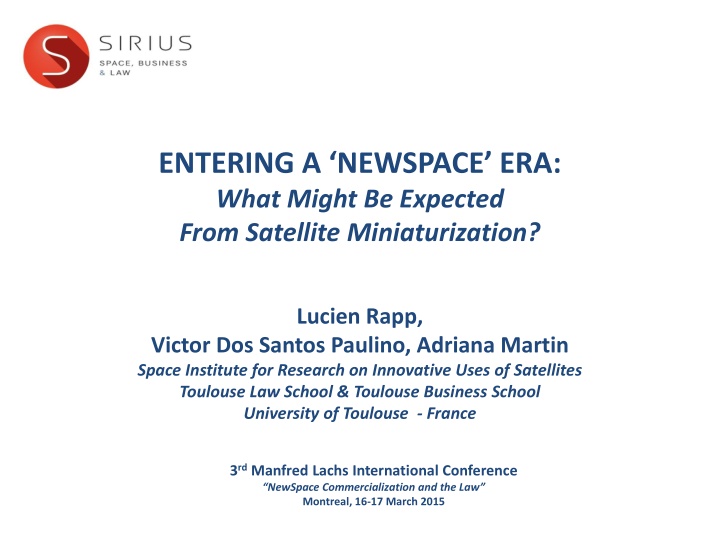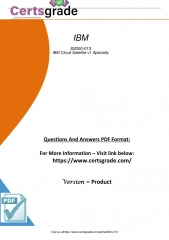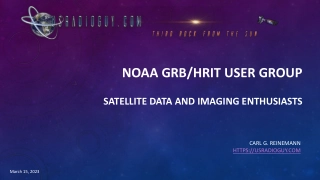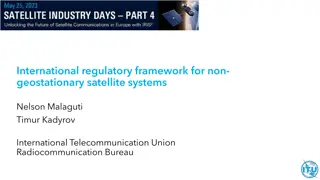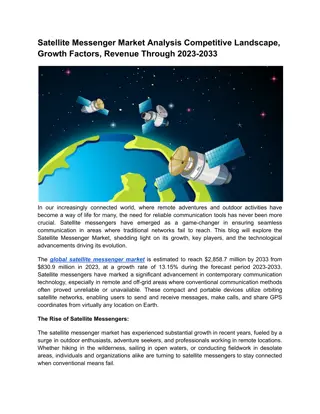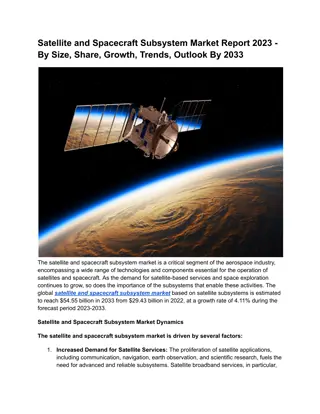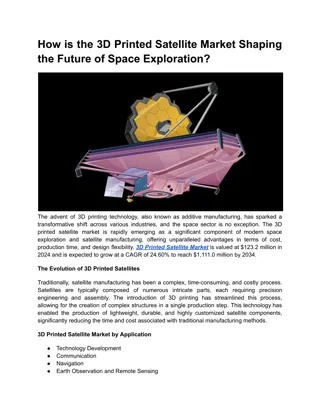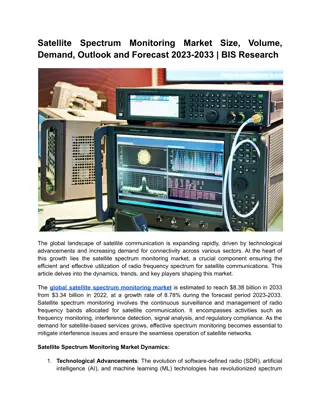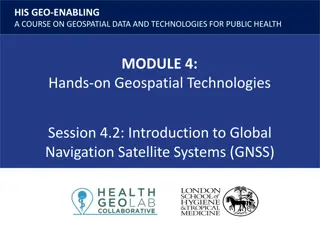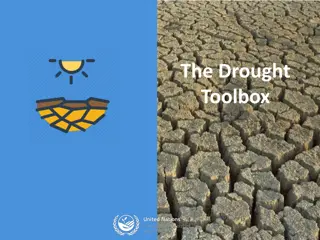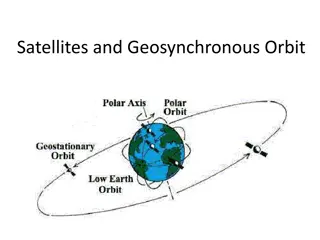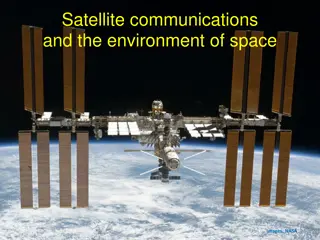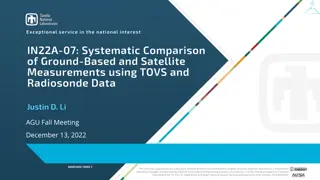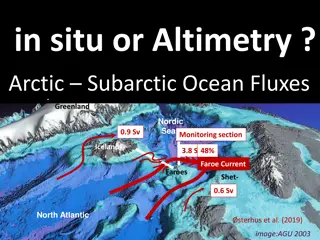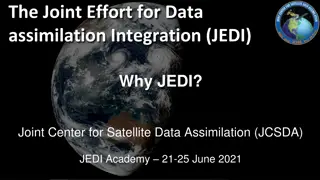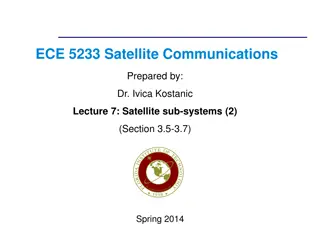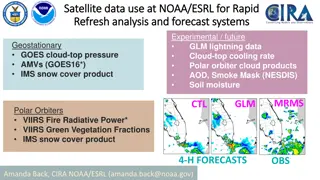Satellite Miniaturization Trends and Market Growth Analysis
The paper discusses the impact of satellite miniaturization on the space industry, showcasing new entrants in the market and the evolution of small satellite classes based on mass ranges. It highlights the transition from student projects to commercial services, emphasizing the advancements in technology driving innovation. The Nano/Micro Satellite Market has exhibited significant growth over recent years, reflecting the increasing demand for smaller, cost-effective satellite solutions.
Download Presentation

Please find below an Image/Link to download the presentation.
The content on the website is provided AS IS for your information and personal use only. It may not be sold, licensed, or shared on other websites without obtaining consent from the author.If you encounter any issues during the download, it is possible that the publisher has removed the file from their server.
You are allowed to download the files provided on this website for personal or commercial use, subject to the condition that they are used lawfully. All files are the property of their respective owners.
The content on the website is provided AS IS for your information and personal use only. It may not be sold, licensed, or shared on other websites without obtaining consent from the author.
E N D
Presentation Transcript
ENTERING A NEWSPACE ERA: What Might Be Expected From Satellite Miniaturization? Lucien Rapp, Victor Dos Santos Paulino, Adriana Martin Space Institute for Research on Innovative Uses of Satellites Toulouse Law School & Toulouse Business School University of Toulouse - France 3rdManfred Lachs International Conference NewSpace Commercialization and the Law Montreal, 16-17 March 2015
Scope The proposed paper is inspired by a SIRIUS exploratory note (to be published), based on a qualitative approach and information collected during five months (April September 2014) The methodology chosen was interviews with professionals and experts in space industry and a case study The SIRIUS case study was in-depth examination of three firm strategies (SSTL, Skybox Imaging and Iridium) 2
New Comers in Space Industry To name a few On the North American market : Skybox Imaging (2009/Google), Planet Labs (2010/Cosmogia Inc.), NovaWurks (2012), OmniEarth (2014), UrtheCast (2014), GeoOptics (2013), SpaceX (2002/Google as a shareholder), Garvey Spacecraft Corp. (2000), Silicon Labs (1996) On the European market : NovaNano (2011), Clyde Space (2005), Gomspace (2007), Deimos Space (2006), Dauria Aerospace (2011), Virgin Galactic (2003), Swiss Space System (S3) (2012) 3
In Common They have started manufacturing, launching and/or operating small, relatively inexpensive satellites into space, those small satellites evolving from student projects at universities to projects by companies and government agencies have attracted development efforts by companies and organizations, particularly as advancing technologies are enhancing the capabilities of the existing space-crafts are yet delivering innovative commercial services, which was once the exclusive domain of governments/institutional. 4
Small Satellite Class and their Mass Range Small Satellite Class Mass Range Mini-satellite 100-500 kg Microsatellite 10-100 kg Nanosatellite 1-10 kg Picosatellite 0.01-1 kg Femtosatellite 0.001-0.01 kg
Nano/Micro Satellite Market The average growth of nano/micro satellites was 37.2% per year over the last 4 years (2010-2014), and it is expected to be 23.8% over the next 6 years (2015- 2021), mostly for earth observation and commercial applications More than 400 nano/microsatellites will need launches annually in the year 2020 and beyond (SpaceWorks, 2014)
Questions Are those new entrants redefining the space market and becoming a threat to the existing firms in the space industry? Could small satellites be characterized as a disruptive innovation that could overturn global space market conditions? Would existing firms in the space sector, as incumbents, start facing an innovator s dilemma (Clayton M. Christensen)? 7
Conceptual Framework Six assumptions (from a review of the academic litterature) : New entrants must be identified in space industry Satellite miniaturization must meet the conditions of a disruptive innovation A complement innovation ( complementor ) must appear to boost satellite miniaturization disruptive innovation A path dependency must be observed in the existing firms (Innovator s Dilemma) Existing firms must implement open innovations New entrants must in turn practice open innovation 8
Are there new entrants in space industry ? (Yes) Firms Location/HQ Year Founded Main Product Main Application UK 1985 Small satellite EO, Navigation, Telecommunication, SSTL Research Korea 1999 Small satellite Earth Observation Satrec Initiative Spain 2001 Small satellite Earth Observation Deimos Space California (USA) 2006 24 small satellite constellation Environmental, Weather Monitoring GeoOptics Denmark 2007 Nano and cube satellite Research, Low-Cost Science Gomspace Scotland 2008 Nano and cube satellite Research Clyde Space California (USA) 2009 24-satellite constellation Earth Observation Skybox Imaging France 2009 Nano satellite Earth Observation NovaNano California (USA) 2010 100 cubesat constellations Earth Observation Planet Labs California (USA) 2011 Nano and cube satellites Scientific Mission Tyvak-Nano Satellite System California (USA) 2011 Hyper-integrated satellite Space Exploration Novawurks German, Russia 2011 Small satellite EO, Communication, Navigation Dauria Aerospace Maryland (USA) 2012 12-24 small satellite constellation Weather Monitoring PlanetiQ Virginia (USA) 2013 18-small satellite Earth Observation OmniEarth
Are Small Satellites a Disruptive Innovation? (Yes) A disruptive innovation Small satellites Has inferior performance as compared to existing product Lifetime ranging from a few months to 5 years (compared to 15 years of traditional large satellites) Address a different, underserved still marginal market (sumpler, cheaper, non competitive accordin to traditional space market parameters) Serves a market segment that did not exist before and which Existing firms not concerned by small satellite business, so that new entrants can take the business with unusual business models (standardizedspace qualified spacecrafts components via an online shop to individual customers) Is ignored by existing firms (due to very low profit margins)
Does a complementor exist for small satellites? (No) List of launch vehicles available for small satellites to go to low-earth orbit Launch Vehicles Company (Country) Capacity to Low Earth Orbit Taurus OSC (US) 860-945 kg Pegasus OSC (US) 450 kg Minotaur OSC (US) 1700 kg PSLV ISRO (India) 1300 kg Shavit IAI (Israel) 340 kg Dnepr Yushnoye (Ukraine) 3600 kg Epsilon JAXA (Japan) 1200 kg (not yet operational) Cyclone Yushnoye (Ukraine) 4000 kg (not yet operational) 11
Is path dependency observed in the existing firms? (Yes) Space industry Is still strongly dominated by governmental programmes Does not have yet a market structure based on full competitive free market Is naturally high risk adverse ( failure is not an option ) Leaves little freedom for innovation (not strictly needed for mission success), Gives rise to technically conservative behaviors from space engineers and project managers (a strong inhibitor against fundamentally new approaches)
Do existing firms employ open innovation? (No) Outside-In: Inside-Out: o o Leverage other industries: agile aerospace (to be done like in software industry: release early and often), analytical platform for big data (from the internet), use smartphone flash memory, simplify testing (not typically done in traditional space industry) Using COTS: not space-proved components or ready-to-buy components (without specific contracts or specification) Acquisition/spin-in: to acquire new technology Licensing-in: to buy a patent license Crowd-sourcing/open-sourcing: outsource activity to the crowd Collaboration with others Innovation through communities/users: rely on communities/lead users; e.g. hosted payload Divestment/spin-out: to pursue outside the technology developed inside Licensing-out: to grant a patent license o o o Existing space firms do not implement open innovation. o o o o
Do new entrants practice open innovation? (Yes) Smaller teams Significant use of commercial off the shelf technologies Crowdfunding A more aggressive approach to managing risk A great motivation to leverage intellectual property or other industries
Discussion No Necessary Conditions Status i There are new entrants Accepted ii Small satellite is a disruptive innovation in space industry Accepted iii There is a complementary product to complete the disruptive innovation Rejected iv The existing firms are implicated with path dependency Accepted v The existing firms do not implement open innovation Rejected vi The new entrants implement open innovation. Accepted 15
Scenario 1 Assumptions Conclusions There are new entrants; Small satellite is a disruptive innovation in space industry The existing firms are implicated with path dependency The new entrants implement open innovation Provided that the mechanisms observed and studied in fully competitive free markets are applicable to the space domain, traditional existing firms might need to take these developments serious and deploy proactive strategies to include these fully into their planning and future business scenarios Risk: the moment when Kodak, a market leader in the film business in the 20th century failed to respond to changes in technology, choosing not to move into digital photography and consequently, letting others to dominate the digital photography.
Scenario 2 Assumptions Conclusions There is no complementary product to complete the disruptive innovation We head to a space bubble (a severe business cycle; a time period where business activity increases very rapidly - for example a lot of new entrants show up -, followed by sharp and rapid contraction) which could be as much devastating as the previous one in the early 90s. Should it be true, this scenario might have this time a significant impact on the financial sphere (banks, insurance companies, and investment funds) in the context of (European) bear markets The existing firms implement open innovation
Questions? lucien.rapp@ut-capitole.fr
